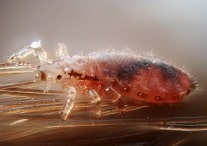The term pediculosis comes from scientific Latin, where the word pediculus is used to refer to the louse (an insect that is parasitic on humans and other mammals). Pediculosis is the infestation of lice and the skin disease caused by these organisms.
It is important to know that the term we are now dealing with was formed from the union of that noun “pediculus” and the suffix “-osis”, which is used to indicate “disease” or “process”.
 The louse is an ectoparasite since it resides on the surface of another species. Since the infestation of parasites is called parasitosis , pediculosis is classified as an ectoparasitosis (a parasitosis caused by an ectoparasite).
The louse is an ectoparasite since it resides on the surface of another species. Since the infestation of parasites is called parasitosis , pediculosis is classified as an ectoparasitosis (a parasitosis caused by an ectoparasite).
An interesting fact that is worth knowing is that both humans and animals can suffer from pediculosis. The only difference is that the louse that affects some and others is different.
It is a skin disease (that is, a dermatosis ) that is contagious. In the case of humans, the most common pediculosis is caused by Pediculus humanus capitis , colloquially known as head louse .
This ectoparasite settles on the scalp , which is the skin that covers the skull and where the hair arises. Once installed, the louse places its eggs ( nits ) in the host's hair and feeds on the person's blood.
Because these lice are not vectors of known diseases, pediculosis caused by Pediculus humanus capitis is not serious. It only creates discomfort by generating itching; In some rare cases, however, it can lead to the development of a secondary infection as a result of scratching.
In addition to the symptoms mentioned, we can also establish that pediculosis can be shown through severe itching or through the appearance of small scabs that can even ooze.
The ways to become infected with head lice are basically in these three ways:
-Being close to someone who has lice.
-Touching the clothing or hygiene products of someone who suffers from pediculosis.
-Sharing hats, towels, combs or other items with similar characteristics with a person who is infected.
Other types of lice can also cause pediculosis to appear on the body or specifically on the pubic area . Beyond the differences in each treatment, in general, head lice is combated by bathing daily and washing bedding and clothing with hot water.
However, treatment may also consist of these other measures to take into account:
-Applying specific products and medications that can be prescribed by the doctor or that can be purchased in pharmacies.
-Removing nits with combs that are specific for that work.
-In the same way, it is possible to choose to follow some homemade tricks that exist in this regard. Among those, applying a mixture of hot water and vinegar to dry hair or massaging the scalp with garlic are considered the most effective.
